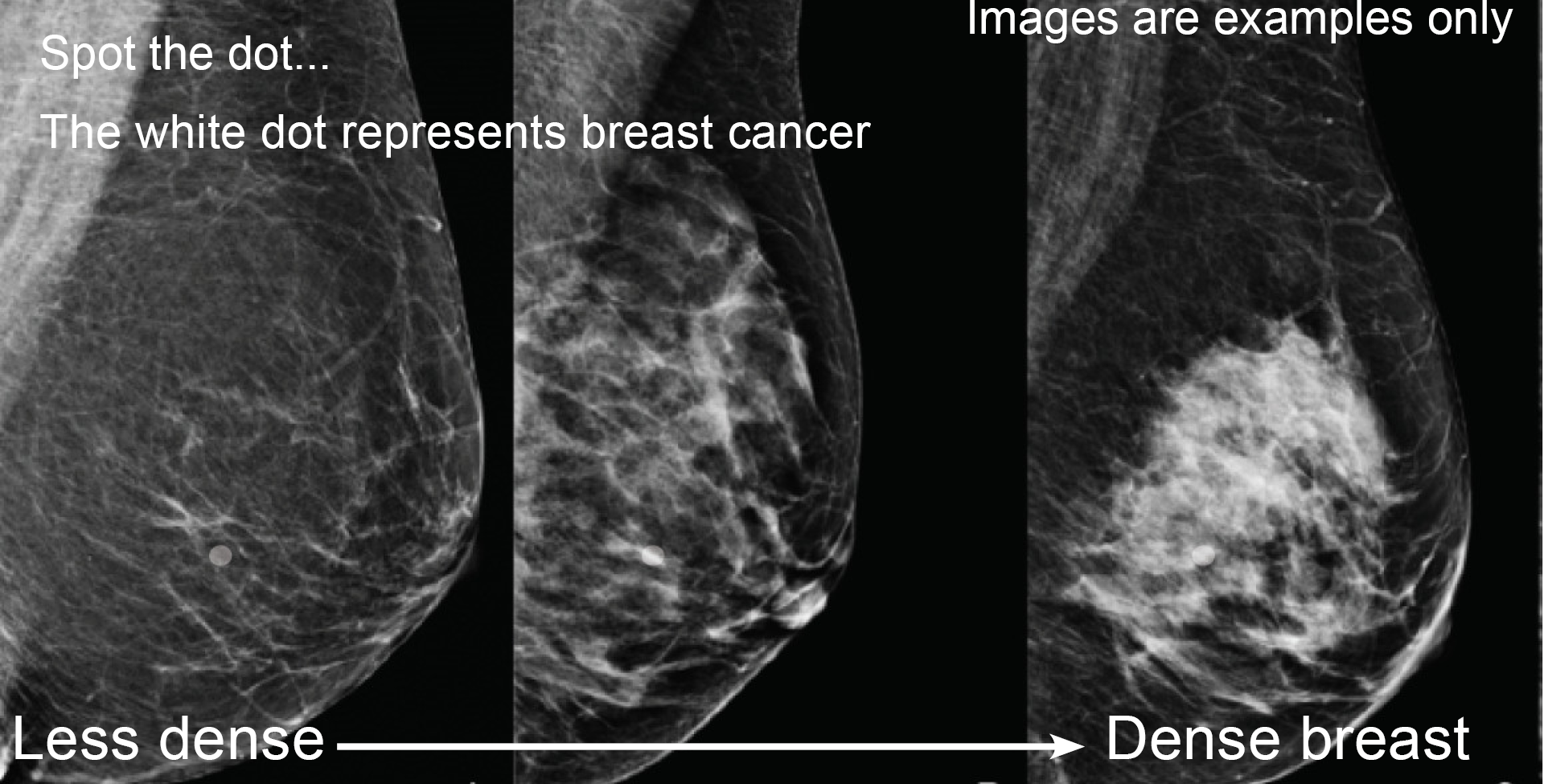Dense breasts
What is breast density?
Women’s breasts are made up of different types of tissue including fatty tissue, glandular tissue and connective tissue. Women with low breast density have more fatty tissue compared to glandular tissue while women with high breast density have more glandular tissue compared to fatty tissue.
Breast density describes how breasts look on a mammogram. It does not describe how breasts feel on examination by a woman or their doctor. On a mammogram, dense breast tissue appears white whilst fatty breast tissue appears dark. Breast density has the potential to hide breast cancers that also appear white on the mammogram image. Therefore, screening mammograms are a less sensitive test for breast cancer in women with dense breasts.
Dense breasts are common and normal, occurring in approximately one third of women over 50 years. Dense breasts are very common in younger women (aged less than 50 years) and for many, breast density decreases as women get older. For example, only about 25 percent of women aged 60 and older have dense breasts. Breast density varies from woman to woman. Factors including age, body mass index (BMI), having children, going through menopause and being on hormone replacement therapy (HRT) can influence the density of a woman’s breast tissue.

The greater the breast density, the more white areas on the mammogram, and the less obvious the dot (which is an artificial representation of breast cancer).
Why is breast density important?
Research shows that higher breast density is associated with an increased risk of breast cancer. It is important to remember that the risk of developing breast cancer is influenced by a range of other factors including:
- increasing age (the biggest risk factor)
- having a strong family history of breast cancer
- previous history of breast cancer
- ovarian cancer
- being overweight
- drinking alcohol
- taking HRT and
- other lifestyle factors.
Screening mammograms and breast density
BreastScreen WA notifies women and their GPs when a mammogram shows marked increased breast density. Women are advised in writing to consult their GP to discuss the significance of their breast density, to have a clinical examination and receive further advice about their breast cancer risk.
What you can do if you have dense breasts?
- Women aged 50-74 years with no breast symptoms are recommended to have a free screening mammogram with BreastScreen WA every 2 years. It is still the best screening test for the early detection of breast cancer.
- Be “Breast Aware”; get to know your breasts and what is normal for you. Look in the mirror at your breasts and feel your breasts from time to time. If you notice any unusual changes in your breasts even if your last mammogram was normal, please see your GP promptly.
- See your GP for regular breast examinations.
Should women with dense breasts have additional tests?
Currently there is no evidence that additional tests are routinely advised for all women with dense breasts. Some women, who may be at higher risk of breast cancer due to additional risk factors, may benefit from extra tests e.g. breast ultrasound. If you have been notified that you have dense breasts, BreastScreen WA recommends you see your GP to discuss this.
If I have dense breasts, do I need to have mammograms or breast ultrasounds every year?
There is currently no evidence that women with dense breasts need more frequent screening mammograms.
Women are recommended to keep their usual screening schedule, which for the majority is every two years.
Some women may have had breast ultrasounds on the recommendation of their GP or specialist. There is currently no evidence that annual breast ultrasounds are needed for women with dense breasts who have no family or personal history of breast cancer.
How can I keep informed?
BreastScreen WA will keep its website updated with the latest recommendations for women with dense breasts.
Get to know your breasts and what is normal for you. Look in the mirror at your breasts and feel your breasts from time to time.
If you notice any unusual changes in your breasts such as lumps, nipple discharge, or persistent new breast pain, even if your last screening mammogram was normal, please see your GP promptly.
Ask your GP about breast health at your next check-up.
Use our contact form or call BreastScreen WA on:
13 20 50 for appointments
9323 6700 for information

